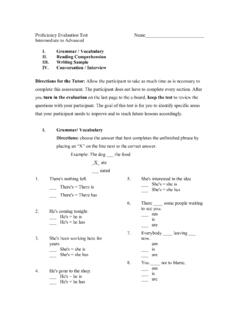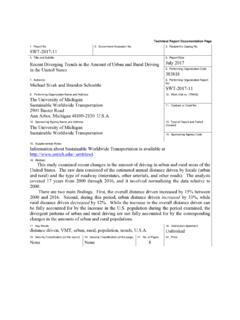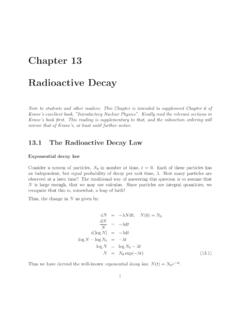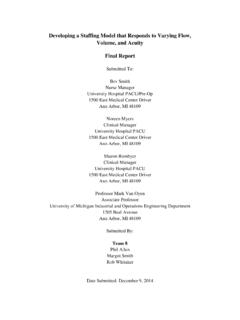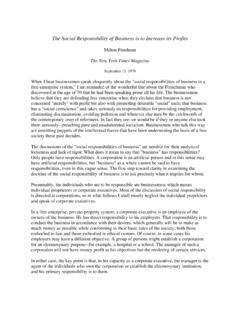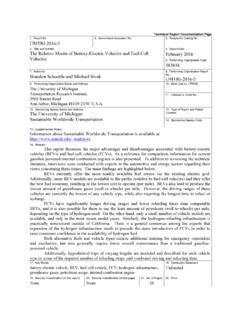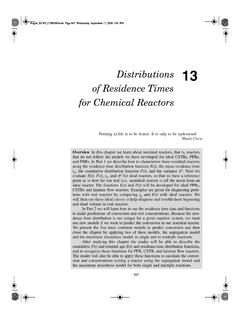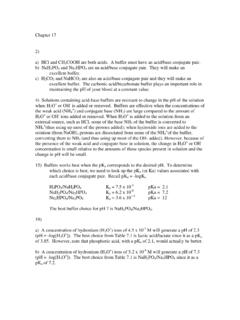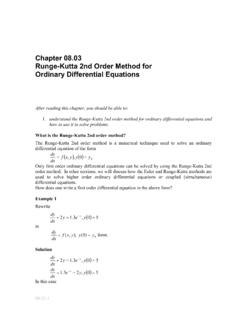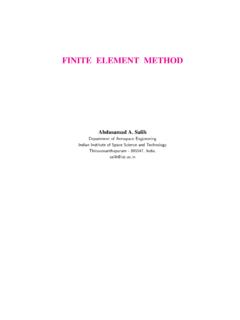Transcription of MATLAB Tutorial on ordinary differential equation solver ...
1 MATLAB Tutorial on ordinary differential equation solver (Example 12-1) Solve the following differential equation for co-current heat exchange case and plot X, Xe, T, Ta, and -rA down the length of the reactor (Refer LEP 12-1, Elements of chemical reaction engineering, 5th edition) Diffe re ntial e quations d(Ta)/d(V) = Ua*(T-Ta)/m/Cpc d(X)/d(V) = -ra/Fa0 d(T)/d(V) = ((ra*dH)-Ua*(T-Ta))/Cpo/Fa0 Explicit e quations Cpc = 28 m = 500 Ua = 5000 Ca0 = Fa0 = dH = -34500 k = *exp((7906)*(T-360)/(T*360)) Kc = *exp(( )*((T-333)/(T*333))) Xe = Kc/(1+Kc) ra = -k*Ca0*(1-(1+1/Kc)*X) Cpo = 159 Initial and final value s Ta(0) =315 T(0)= 305 X(0)=0 V(0)=0 V(f)= 5 Re pe at the s imilar e xe rcis e for othe r cas e s : Counter-current heat exchange: Plot X, Xe, T, Ta, and rA down the length of the reactor Constant ambient temperature, Ta: Plot X, Xe, T, and rA down the length of the reactor Adiabatic operation: Plot X, Xe, T, Ta, and rA, down the length of the reactor Ste p 1: First, launch MATLAB which you can access on CAEN computers (University of Michigan computer) or download from.
2 You will see that multiple window opens which looks like this The central window is called Command window. In the command window you can enter statements, run your files, generate output etc. Ste p 2: Change the current folder location The only folder which MATLAB can access is shown by red circle. In this case the folder name is MATLAB . You must change the access location so that it refers to your particular folder which you are using for this project. Let s create a folder LEP-12-1 on desktop. Now change the MATLAB folder location to this location as shown below To solve ODE in MATLAB , you need to create two kind of program files: 1. Script file where you enter data such as integration span, initial guess, produce graphica l outputs,etc 2.
3 Function file where you enter all your explicit and differential equations We will first create function file Creating function file Ste p 3: On the toolbar, Click on the New menu and select Function You will see a new window opens that looks like this. MATLAB automatically creates syntax for writing function file. To use solver in MATLAB , you need to write codes in the space provided. The first line of function starts with the keyword function followed by the output arguments. The right side contains function name (Untitled) and its input arguments. In this Tutorial , we have chosen the function name as ODEfun which takes two input arguments V and Y. The first input argument V refers to integration span initial and final value of volume of reactor (in this case, Vinit=0, Vfinal=5).
4 Second input argument Y refers to initial values of the dependent variable Ta, T, and X (in this case, Ta(0)=315, T(0)=305, and X(0)=0 ). The values of V and Y will be defined in the script file and then passed to the function file. Step 4: SAVE your file. Let s name the function file as ODEfun. MATLAB file is saved with extension .m . In this case, your function file is saved with the name Ste p 5: Define function output arguments by f. The syntax for creating function file in our case becomes Function f=ODEfun(V, Y) Where V, Y are local to function. Note that f, V, and Y are just variables. You can use whatever terms you like. Just remember that if you have defined a variable, then you have to always refer to it by the same name.
5 Now, edit the inbuilt format of function file for your case as shown below Ste p 6: As the differential equation contains 3 dependent variables (Ta, T, & X), so Y vector contains initial values of these 3 variables, where, Ta is the first element, T is the second element and X is the third element of Y vector So, Ta=Y(1), T= Y(2) and X=Y(3) Assign the initial values of these variable as shown below. Put a semi-colon after each line to prevent the value from being displayed on the command window each time you run the file Ste p 7: Before entering all the explicit equations, we will first write comments (which are not executed). To write comments, use percent symbol (%) followed by the comment. By default MATLAB uses green colour for writing comments.
6 Let s put the comment % Explicit equations Ste p 8: Now, enter all the explicit equations with semi colon at end Ste p 9: Next, you need to enter your differential equations. For this example, you have three differentia l equation in Ta, T and X. In MATLAB , LHS of differential equations cannot be entered in derivative form (dy/dx), so you need to define variable representing left side of differential equation In this case we will use the following definition for differential equation dTa/dV=dTadV, dT/dV=dTdV, and dX/dV=dXdV Enter the comment for differential equation and then enter your differential equations.
7 After all the equations are entered, you need to define the output f. In the function file, f contains the differentia l equation . So, define f as shown below. ODEfun must return column vectors, so, you need to put semi-colon between differential equations to get column vector for different dependent variable. The function file returns the value in the form [v y] where, v is a column vector [ 1 2 ] of independent variable ( volume for this case) and y is a matrix [ 1 1 1 2 2 2 2 ] of dependent variable ( Ta, T, & X for this case). Note that no of rows are same in vector v and matrix y. The return value of the function will be used in the script file which would be discussed in next section Creating a script file Ste p 10: Go back to New menu and select Script A black window will appear like this Ste p 11: First we will create the codes for Temperature profile.
8 So save your script file with the name Temp_profile . You can also save it with other name as per your wish. We will save this file in the folder LEP-12-1 as shown Ste p 12: In the blank space, Enter clc in the first line. It will clear all the input and output from the Command Window display, giving you a clean screen Next you need to enter the integration time span. In this case we want to integrate the volume of reactor from V=0 to V=5. Let s define the integration time span variable as Vspan. To enter this in a row vector format, type Vspan = [0 5] with space between 0 & 5 else enter Vspan= [0 ; 5] to create a column vector. You can either create row or column vector, the output will remain same for this case.
9 We will create a row vector. Next you need to enter the initial values of the dependent variable, Ta, T, X Ta (0) =315, T (0) =305, and X (0) =0 Enter the initial value of the dependent variable in the vector form y0= [315 305 0] Again putting semi-colon at the end of each statement prevents the value from being displayed on the command window. We will also put comment against each line as shown below Ste p 13: Next, you need to choose your ODE solver . There are different kind of solver available in MATLAB which you can use as per your problem requirement. The following is the list of all the solver with details: Solve r Proble m Type Orde r of Accuracy Me thod Whe n to Us e ode45 Nonstiff Medium Explicit runge - kutta Most of the time.
10 This should be the first solver you try. ode23 Nonstiff Low Explicit runge - kutta ,pair of Bogacki and Shampine For problems with crude error tolerances or for solving moderately stiff problems. ode113 Nonstiff Low to high Adams-Bashforth-Moulton PECE For problems with stringent error tolerances or for solving computationally intensive problems ode15s Stiff Low to medium Numerical differentiation formulas (NDFs) If ode45 is slow because the problem is stiff. ode23s Stiff Low Modified Rosenbrock If using crude error tolerances to solve stiff systems and the mass matrix is constant. ode23t Moderately Stiff Low Trapezoidal rule using a "free" interpolant. For moderately stiff problems if you need a solution without numerical damping ode23tb Stiff Low Implementation of TR-BDF2, an implic it runge - kutta formula with a first stage that is a trapezoidal rule step and a second stage that is a backward differentiation formula of order two If using crude error tolerances to solve stiff systems.
